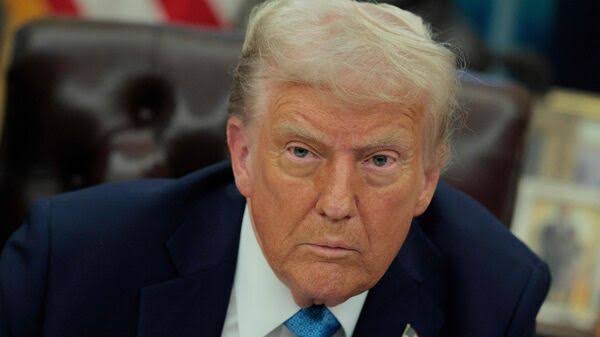…Canada ‘won’t relent’, says Trudeau
U.S. President Donald Trump said there is “nothing” Canada can do to prevent the punishing tariffs expected to be unleashed tomorrow.
During a press conference in the Oval Office Friday afternoon, Trump was asked if there’s “anything” Canada, China or Mexico could do to forestall the tariffs. The president left little up for interpretation
“No, nothing. Not right now. No.”
He was later asked if he was looking for a “concession” from the three countries. Trump responded that he was not. “We’ll just see what happens.”
Prior to Trump’s comments, White House Press Secretary Karoline Leavitt repeated the president’s reasons for the tariffs, saying “massive amounts of fentanyl” are crossing into the U.S. from Canada.
“The president will be implementing tomorrow a 25 per cent tariff on Mexico, 25 per cent tariffs on Canada, and a 10 per cent tariff on China for the illegal fentanyl that they have sourced and allowed to distribute into our country, which has killed tens of millions of Americans,” she said.
Trump also reiterated his view that a “$200 billion” USD trade deficit between Canada and the U.S. is a reason for implementing tariffs.
“(Canada has) treated us very unfairly, and I say why should we be subsidizing Canada?” Trump said.
In 2024, the U.S. deficit with Canada was estimated to be around $45 billion, according to TD Economics. In a report published online, TD noted that it’s unclear where Trump got the $200 billion figure, which “is roughly four to five times the officially reported statistics.”
Trump’s comments Friday is the latest moving target as for when tariffs could be imposed.
Trump initially threatened in late November to impose across-the-board 25 per cent tariffs on all imports from Canada and Mexico on “day one” of his second term.
That didn’t happen. Instead, he signed an executive order initiating a study on broader trade practices, to be completed by April 1, and then later throwing out Feb. 1 as the implementation date for border-related tariffs.
Speaking to reporters late Friday from Washington, D.C., Foreign Affairs Minister Melanie Joly says the federal government has yet to see “any form of pure decision making” or “any form of specific details coming from the White House regarding (Trump’s) comments.”
Trump to ‘probably’ hit Canadian oil with 10 per cent tariff
In his press conference, Trump provided more details on the timing of tariffs on oil and gas, saying he is targeting Feb. 18.
Trump also said he’ll “probably” bring tariffs on oil down to 10 per cent.
“I’m probably going to reduce the tariff a little bit on (oil). We think we’re going to bring it down to 10 per cent on the oil. So it’s 25 per cent when on the Canadian side.”
The United States is the primary destination for Canadian crude oil, climbing to a record 4.3 million barrels per day, according to October 2024 figures from the U.S. Energy Information Agency.
Alberta Premier Danielle Smith, who has been advocating for oil and gas to be exempted from any potential tariffs, is awaiting further details.
“The Premier has been clear from the start that any tariffs imposed by the U.S. on Canadian goods will hurt American and Canadian consumers, workers and businesses. That view has not changed,” Smith’s press secretary Sam Blackett said in a statement on Friday.
Trump also said he’s planning to implement tariffs on steel and aluminum but did not provide specifics on which of the three countries will bear the brunt, or when.
Trudeau: Canada ‘won’t relent’
Canada’s politicians have spent several weeks trying to coordinate a potential retaliation plan.
Speaking earlier on Friday in response to Trump’s Thursday assertion that he was ready to hit Canada with tariffs tomorrow, Trudeau said Canada “won’t relent until tariffs are removed,” but conceded the country could be in for hard times.
“I won’t sugar-coat it. Our nation could be facing difficult times in the coming days and weeks,” Trudeau said Friday ahead of a meeting with his Canada-U.S. relations council in Toronto.
“I know Canadians might be anxious and worried. I want them to know the federal government, and indeed, all orders of government have their backs.”
Amid the conflicting messages in recent days from Trump and his pick for commerce secretary Howard Lutnick, Trudeau said while Canada still does not know precisely what could be coming, “we’re ready with … a purposeful, forceful but reasonable, immediate response.”
Speaking to reporters on Friday, Trump’s press secretary had harsh words for Trudeau’s vow to retaliate.
“I think Justin Trudeau would be wise to talk to President Trump directly before pushing outlandish comments like that to the media,” Leavitt said.
The federal government has a three-round retaliation planned, which would start by singling out a small list of American-made consumer products such as Kentucky bourbon and Florida orange juice.
This targeting would be followed by tariffs on a longer list of U.S. goods worth $37 billion and then, if needed, Canada would hit an additional $110 billion in manufacturing and other products with trade action.
Canada’s border plan pitch falling short?
Federal cabinet ministers continued their outreach efforts in Washington on Friday, which included a meeting with Trump’s border czar Tom Homan.
Despite new measures by the federal government to fortify the border with a $1.3 billion plan, Trump has repeated his concerns about Canada’s border with the U.S.
Asked by reporters on Friday whether Canada’s border plan “was in vain,” Public Safety Minister David McGuinty said progress at the border is being made.
“We’ve made huge improvements on different fronts, including dealing with migration, dealing with the fentanyl problem. We continue to make progress, and we’re very encouraged,” McGuinty said.
Immigration Minister Marc Miller, meanwhile, says he does not believe the tariff threat is about the border.
“The facts, I believe, do set you free, and the facts that we exposed (to) the Americans today, I think are important in the discussions that Mr. Trump will be briefed on,” Miller said.
According to U.S. Customs and Border Protection (CBP), nearly 24,000 encounters with migrants were recorded between posts on the Canada-U.S. border between October 2023 and September 2024, which is a significant surge compared to 916 encounters during that same period in 2021. That number though is well below the 1.5 million that entered the U.S. from Mexico between October 2023 and September 2024.
CBP has also told CTV News that expanded enforcement efforts to respond to “changing migration trends” has reduced encounters at the northern border between official ports of entry by more than 80 per cent from June to November of last year.
And when it comes to fentanyl, the CBP says only 43 lbs of the drug has been seized at the Canada-U.S. border in the past year compared to 21,148 lbs at its southern border with Mexico.
Asked if the federal government has any indication of when Trump will make his final decision on tariffs, Joly said, “I’m not in the headspace of President Trump.”
“I think that the reaction towards our border plan, or the reaction regarding just the fact that there is a trade surplus when it comes to goods between Canada and U.S., if you don’t take into account the question of energy … people are reacting extremely positively,” Joly said.
These latest efforts come as the Wall Street Journal reported late Thursday that Trump’s aides were considering offramps for the president to make a deal to dial back the Canada-Mexico tariffs.
How tariffs will hurt on both sides
“We’re in a critical moment,” the prime minister said of the looming trade war with Canada’s biggest trading partner, noting such action would have a detrimental impact on both countries’ deeply linked economies.
According to analysis from the Canadian Chamber of Commerce, a 25 per cent tariff could shrink Canada’s GDP by 2.6 per cent and cost Canadian households an average of $1,900 annually.
South of the border, it would result in a 1.6 per cent GDP drop and an average $1,300 hit to American households.
“We will see jobs affected by this. We will see employers really, really struggling and it’s important in Canada to remember that 98 per cent of our employers are small and medium enterprise,” Canadian Chamber of Commerce public policy chief Matthew Holmes said in an interview with CTV News.
Sources tell CTV News that the federal government is planning a potentially pandemic-sized stimulus package to help businesses, but the scale of that relief would depend on the scope of what Trump dishes out.
According to Holmes, the federal government needs “to be careful” and be “precision-targeted at the beginning” when it comes to any supports.
“If there’s a lesson from the pandemic, it’s that government money flooding into the economy also is a double-edged sword for inflation and for other supply chain issues that we face in our economy,” Holmes added.
Daily, $3.6 billion in goods cross the Canada-U.S. border, and Canada is the top export market for 34 U.S. states, sustaining millions of jobs and businesses.
Story Source : CTV News With files from Reuters, Spencer Van Dyk and Stephanie Ha












Leave a Reply